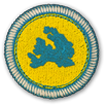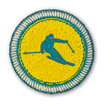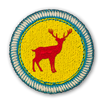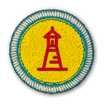
Aska
Ash
#ashcloud was one of the first truly viral hashtags on social media, established around a cloud of ash that was being spewed from the Icelandic volcano Eyjafjallajökull. It grounded air traffic for more than 10 days across Europe and North-America in 2010. Iceland experiences a volcanic event every five years, on average. Usually, the effects are mostly local, but the lava fields offer a spectacular view.

Brekka
Slope
Every hill has the potential to be a great ski slope, given the right weather conditions. When winter brings snow, Icelandic kids take out their sleds and find the closest brekka to slide down. For skiing, you need a larger slope and preferably a ski lift. There are many great skiing areas all around the country. Heli-skiing is an adventurous option for those looking for pristine slopes.
Dansandi
Dancing
The most breathtaking show in Iceland is put on by the northern lights as they spontaneously dance across the skies, changing colours from green to pink and growing suddenly in size before disappearing, leaving the audience with a magical feeling. Sadly, you cannot book a ticket to this show but you can join a Northern Lights tour to search for them. The aurora borealis can only be seen in the winter, the season starts in mid September and ends in mid April. Your chances are best on clear, crispy nights. Pick a night with clear skies and make use of the Met office's northern lights forecast.

Vellíðan
Well-being
Thermal pools have been relished for pleasure and health benefits in Icelandic society since the first centuries of settlement. Pool culture continues to play an important role in today's society as locals of all ages and professions gather in public pools for exercise and gossip.
As of the late 20th century, geothermal water has also been utilised in luxury spa settings. The most famous of these is the Blue Lagoon, whose high levels of silicates and other minerals have an especially rejuvenating effect on the skin.

Endi
End
One end of Iceland is in Látrabjarg, the westernmost point of the country. It is a line of remote birdcliffs with an incredible variety of birds, one of the best places for birdwatching in Iceland (other popular places include West and North Iceland). The birdlife is sheltered from foxes on these cliffs, and you can get very close to the birds, including puffins. Remember to watch your step near the steep cliffs.

Séður
Astute
The root of the word is to see, and its meaning is to be smart and prepared. This is an essential quality when travelling in Iceland where the weather can change in a moment and being séður will save your day. Make sure to bring a weatherproof jacket and expect rain and wind at some point, and sturdy hiking shoes as you might spontaneously hike up a nearby mountain.

Flekaskil
Plate boundary
Iceland is located where the North American and Eurasian tectonic plates meet. As a result, we often see small-scale earthquakes. We are moreover situated on top of a volcanic hotspot, which is why we have active volcanoes and an abundance of hot water that sometimes boils above ground and erupts. We use this same hot water to heat our houses and our swimming pools.

Gamalt
Old
When undertaking a trip to Iceland, one would hardly want to forget the country's namesake – i.e. its 11,000 km2 of glacier ice. While ice climbing on waterfalls is only possible in winter, it can be practiced year-round on glaciers. This is above all done on the Sólheimajökull and Svínafellsjökull glaciers near the south coast. Other glacier spots can also be arranged, with hiking also available onto Snæfellsjökull glacier in the West and other parts of Vatnajökull glacier in the East. Of course, glacier walking or climbing should never be attempted without the proper equipment and in the company of a trained guide. Glacier walking tours can often be combined with other tours such as jeep safaris and boating on a glacier lagoon.
These tours offer visitors an invigorating first-hand experience of Iceland's untamed nature, tailored to various levels of experience and difficulty. Crampons and ice axes are generally provided and hiking boots are often available for rent, but it is recommended that the tourist bring at least a waterproof jacket and pants, quick-dry trousers, a sweater, hat and gloves.
Hækkun
Elevation
Hiking is a popular pastime in this mountainous country. And for a good reason. There are ample opportunities for a wide range of excursions, and just so much to see. Even if you are only planning on an easy trek up a hill, make sure you wear sturdy shoes and proper clothing. Conditions can change fast and as always, safe is better than sorry.
Indæll
Nice
Icelanders are a friendly bunch, despite a somewhat cool demeanor. It is customary to adapt a quiet and reserved persona in public situations, which some guests have mistaken for being stand-offish. Not the case. Don’t be afraid to reach across the cultural barrier. It’s a rewarding experience.

Ísilagður
Covered in ice
In a country that draws its name from ice, can expect to encounter ice at some point. Take care if you are travelling in winter. The ground may be frozen and extremely slippery. Especially around waterfalls. You should also be prepared to drive on icy roads. The ice is sometimes invisible so make sure to pay attention if temperatures are below freezing during your visit.

Jaki
Iceberg
The Southeast of Iceland is home to the glacial lagoon, Jökulsárlón, and what has become known as the Diamond Beach. These are very popular stops with tourists and photographers. You might spot seals swimming lazily around the icebergs. You can even sail between them in the summertime. These magical places are located right below Europe’s largest glacier, Vatnajökull.

Landnámsmaður
Settler
Ingólfur Arnarsson is considered to be the first permanent settler in Iceland. He arrived on these shores in the year 871, and settled in Reykjavík. However, there is archeological evidence of settlements in Iceland prior to that time. Irish monks are believed to have resided here, at least temporarily as far back as in the 8th century.

Myrkur
Darkness
Due to its northerly location, winter days in Iceland are somewhat sparse in the number of available daylight hours. The early dusk and predominant darkness of winter has bred several chilling stories of lost souls and wandering spirits. But even in Iceland, nothing will prepare you for the pitch black of the underground. There are many large caves and lava tunnels accessible in Iceland. They offer an interesting glimpse into the geological history of the earth, and the creative power of nature. This is your change to go where the sun, literally, does not shine.

Nærgætinn
Considerate
The rugged exterior of Icelandic nature may seem like it is built to withstand anything. But Icelandic vegetation is particularly vulnerable so please tread carefully. We want to protect these delicate areas for future generations to enjoy. Please become a responsible tourist and take the Icelandic Pledge.

Orðlaus
Speechless
Icelandic scenery can leave people speechless. It is easy to get distracted by the beauty of the surroundings while driving in Iceland. If a breathtaking photo opportunity comes into view, please find a safe place to stop, outside of the road you are on. You may be tempted to stop in the middle of the road. Don’t. This will endanger you and other travelers.

Pysja
Puffling
Baby puffins, or pufflings, are called pysja, and they are the most adorable creatures, but have yet to grow their colorful, distinctive beak. Popular puffin sighting spots are Dyrhólaey and the Westman Islands in South Iceland, Látrabjarg in the Westfjords, Húsavík in North Iceland and Borgarfjörður Eystri in East Iceland. Puffling-saving is a Westman Islands tradition, especially popular with children. They find who have not yet mastered the art of flyging, bring them in to be weighed, measured and marked and then help them find their way to sea.

Risi
Giant
We have giants in our mythology but the best known Icelandic giants are the whales. The species that are most commonly found in Icelandic waters are the minke, humpback and killer whales although white beaked dolphins and harbour porpoises are also regular visitors. Occasionally, with a little luck, you might also spot a true giant, the blue whale, the largest mammal on Earth.

Samkoma
Gathering
The amount of festivals in Iceland is staggering for such a small population, as the locals enjoy a good gathering to celebrate shared interests. All year-round, you will find creative festivals dedicated to music, film, and fashion. During summer, town festivals attract large groups of people around the country, dominating the event calendar, especially during the first weekend of August. With abundant daylight hours during summer, and the long after hours of winter, nothing beats a good festival in Iceland.

Tölt
Tolt (gait)
The horses of Iceland are a so-called gaited horse breed. This means that most Icelandic horses have two extra gaits to offer besides walk, trot and canter/gallop. All horse breeds have these three natural gaits and can perform them without training. The extra gaits that set the Icelandic horse apart from other breeds are called tölt and flying pace.
Tölt is the unique four-beat lateral gait, that the breed is best known for. The horse’s hind legs should move well under the body and carry more of the weight on the hind end, allowing the front to rise and be free and loose. Tölt is very smooth to ride since there is no suspension between strides, as is the case in trot or canter, and it can be ridden very slowly up to a very fast speed, depending on the horse.

Umhverfis
Around
Iceland’s most famous highway is Route 1 – the Ring Road, going around the island. Traveling full circle can be done in a matter of days, but there is a lot to see along the way, so plan time accordingly. For an even fuller experience, there are plenty of opportunities to venture off the ring to experience local culture. Extend the trip to include the Westfjords, a beautiful area outside Route 1, and experience all seven regions of Iceland.

Útivist
Outdoor activity
Enjoying nature is an essential part of the Icelandic experience. Simply pick the activity that suits you best; popular options include hiking, sailing, birding, whale watching and horse riding. Just make sure you have appropriate clothing handy. Weather is subject to change.

Varúð
Caution
We cannot stress this enough: Please stay safe during your travels in Iceland. Do not expect high fences at the edges of cliffs or by the sea. We trust that our visitors show common sense and respect the warning signs in dangerous places. That you take pictures to die for without actually dying.

Harðjaxl
A tough person
Harðjaxl, which would literally translate to “hard as a molar” is used to describe a person who’s extremely tough and likely to handle anything without complaint. It is a good characteristic to have when trying to cope with the ever-changing weather. Take the Icelandic attitude to heart and go swimming in a snowstorm or eat ice cream when it’s freezing outside.

Ylja
Warm up
In Iceland there are plenty of intriguing options to warm up your body and soul. You may stumble upon "natural hot pots" during your travels, some are hidden treasures of local farmers, and others are open to the public. The rule of thumb is to treat the pool and surrounding area with respect and make sure not to leave any sign of your presence. These secret spots are an absolute treat to enjoy.

Hýr
Gay
Iceland is a queer friendly country where the legal rights of LGBTQI people are protected. Marriage is not a question of identity or sexual orientation, but an institution of love. Diversity is celebrated every August during the Reykjavík Pride festival, which is a city-wide festival with almost a third of the nation in attendance. Icelanders are firm believers in equality for all.

Ærandi
Deafening
The deafening roar of falling water is eqaully majestic as it is loud. Iceland is carved by powerful glacial rivers making their way from mountaintops to the ocean. Iceland’s rich water supply and mountainous landscape also means that waterfalls are a defining feature of Icelandic scenery..

Ökutæki
Vehicle
All roads are not created equal. In Iceland, you may encounter gravel roads, single-lane bridges, sharp curves, and steep hills. During winter, you can also expect ice, roads that are impassable due to snow, and limited visibility. Always drive in accordance with road conditions, and make sure you have a vehicle that is up to the task. Always exercise caution. All off-road driving and driving outside of marked tracks is prohibited by law. This includes sandy beaches. Icelandic nature is delicate, and tire tracks from off-road driving can cause substantial damage to the vegetation and leave marks that will last for decades. Respect nature and tread carefully.
For information on road conditions, visit Road.is. For safety information, be sure to visit Safetravel.is.
The A-Ö of the regions
Want to continue learning? Discover the A-Ö of the seven regions of Iceland below.


Westfjords
There is something magical about the Westfjords, the region that could arguably be labelled "Iceland's best kept secret". Isolation has preserved the region in a relatively unspoiled wilderness, making it a must-see for any serious explorers.


North
It's all about beautiful contrasts in the North, a land where long valleys and peninsulas are interspersed with big mountains, lava fields and smooth hills carved out by powerful rivers. Go big or go home!


East
If drifting through picturesque fjords from one warm town to the next is your cup of tea, head to the East. It is home to the country's largest forest, lush farmlands and even the mysterious lake monster in Lagarfljot.


Reykjanes
What's so cool about Reykjanes? Not only is it where most visitors set foot in, a geothermal wonder and the home of the spectacular Blue Lagoon, but also a place where lighthouses outnumber villages.


South
If the regions were pop songs, the South would probably be the chart-topping hit, since it is renowned for its beauty and the home of some o f the country's most visited tourist attractions.

















